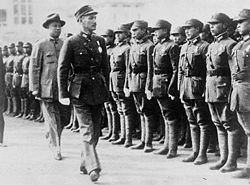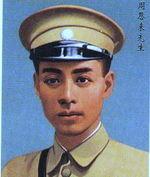- Whampoa Military Academy
-
Coordinates: 23°5′22.5″N 113°25′13″E / 23.089583°N 113.42028°E
 The Whampoa Military Academy emblem includes its motto, which was first proclaimed by Sun Yat-sen at the Whampoa Academy's opening in 1924. It translates into "Fraternity, Dexterity, Sincerity."
The Whampoa Military Academy emblem includes its motto, which was first proclaimed by Sun Yat-sen at the Whampoa Academy's opening in 1924. It translates into "Fraternity, Dexterity, Sincerity."
The Nationalist Party of China Army Officer Academy (simplified Chinese: 中国国民党陆军军官学校; traditional Chinese: 中國國民黨陸軍軍官學校; Mandarin Pinyin: Zhōngguó Guómíndǎng Lùjūn Jūnguān Xuéxiào; Jyutping: Zung1gwok3 Guok3man4dong2 Luk6gwan1 Gwan1gun1 Hok6haau6), commonly known as the Whampoa Military Academy (simplified Chinese: 黄埔军校; traditional Chinese: 黃埔軍校; Mandarin Pinyin: Huángpŭ Jūnxiào; Jyutping: Wong4pou3 Gwan1hau6), was a military academy in the Republic of China (ROC) that produced many prestigious commanders who fought in many of China's conflicts in the 20th century, notably the Northern Expedition, the Second Sino-Japanese War and the Chinese Civil War.
The military academy was officially opened on May 1, 1924 under the Kuomintang (KMT), but the first lessons began on June 16, 1924. The inauguration was on Changzhou Island offshore from the Whampoa dock in Guangzhou, thus earning its common name. During the inaugural ceremonies, Sun Yat-sen delivered a speech that was later to become the lyrics of the national anthem of the Republic of China.
Contents
Establishment
 Sun Yat-sen [middle behind the table] and Chiang Kai-shek [on stage in uniform] at the founding of the Whampoa Military Academy in 1924.
Sun Yat-sen [middle behind the table] and Chiang Kai-shek [on stage in uniform] at the founding of the Whampoa Military Academy in 1924.
After the death of Yuan Shikai, China fragmented into numerous fiefdoms ruled by warlords. Sun Yat-sen attempted in 1917 and 1920 to set up a base in his native Guangdong to launch a northern campaign to unite China under his Three Principles of the People. However, his government remained militarily weaker than local warlords armies. Calls by Sun for arms and money were ignored by the western powers. Then in 1921 the representative of Comintern, Henk Sneevliet (using the name Maring), met with Sun in Guangxi. He proposed to set up a military academy and train the revolutionary army, which confirmed Sun's ideas and he eventually accepted. The Chinese Communist Party sent Li Dazhao and Lin Boqu (林伯渠) to discuss with Sun and his party on how to set up this academy. In 1924, in the 1st National Congress of Kuomintang, the policy of alliance with the Soviet Union and CCP was passed as guidance for KMT. As a result, the final decision of establishment of a military academy was made and preparatory committee was set up accordingly. The money necessary for the construction and support of the Academy in 1924-1925 was provided by the Soviets.
Organization, Training and Students
In the beginning, the Academy had only one department which provided soldiers with basic training. While the main Academy goal was preparation of infantry units, it also provided special classes for artillery, engineering, communication, logistical and machine gun units. A special department for preparation of political agitators was established later.
The academy concentrated the revolutionary military talents at the time. Sun took the job of Premier of this academy in person although it was just an honorary title. Sun's favorite and rising star Chiang Kai-shek was appointed the first commandant of the academy. Liao Zhongkai (廖仲愷), the famous leftist of Kuomintang and Sun's treasury secretary, was appointed as representative of KMT to the academy. Zhou Enlai, Hu Han-min and Wang Ching-wei were among the instructors in the political department. He Yingqin and Ye Jianying were once military instructors.
The serious lack of expert teachers was the biggest problem for the Academy. That is why lectures delivered by Soviet officers were extremely popular among students. A.S. Bubnov, G.I. Gilev, M.I. Dratvin, S.N. Naumov prepared lectures which explained the development of military thought throughout human history and the division between western and Soviet schools of military thought.

Ex-officers of the Russian White Army, who switched to the Soviet side after 1917, taught different military subjects in the Academy using their broad experience gained during the Russian Civil War. Among them were I. Vasilevich (Janovsky), N. Korneev, M. Nefedov, F. Kotov (Katyushin), P. Lunev, V. Akimov. Galina Kolchugina (wife of Vasily Blyukher who was Commander-in-Chief of all Soviet volunteer forces sent to China) read a course of lectures on political agitation.
The first two groups of students prepared by the Academy became the core for the formation of the first two National Revolutionary Army regiments (V.A. Stepanov was an advisor provided by the Soviet Union to help in this matter). The first two prepared groups of students included 500 officers, the third one had 800 officers and the fourth had 2000.
Legendary graduates included Communist commanders Lin Biao, Xu Xiangqian, Zuo Quan (左權), Chen Geng(陳賡), and Nationalist commanders Chen Cheng, Du Yuming, Xue Yue, and Hu Zongnan. These young students first showed their training and courage in the war against local warlord and dissident of Sun, Chen Jiongming (陳炯明), and later the unification of Guangdong province. Then they made greater contributions in the Northern Expedition.
The Muslim Ma clique General Ma Zhongying, who commanded the 36th Division (National Revolutionary Army), attended the Whampoa military academy in Nanjing in 1929.[1][2][3]
Influence
The Whampoa Military Academy plays an important role in Chinese history. Although it is primarily a military academy aiming to train military elites like the United States Military Academy, it has exhibited a broad influence on Chinese history. It not only supplied many military commanders for both the KMT and CCP, but also its graduates have much more influence on both parties' policies and governance. Especially for Chiang and KMT, the Whampoa Clique was pivotal for his governance. It competed with other cliques of KMT such as the New Guangxi Clique led by Li Zongren and Bai Chongxi, CC Clique led by Chen Lifu and Chen Guofu, Politics Research Group led by Yang Yongtai (楊永泰) and Zhang Qun (張群). At the same time, when the CCP built its first Red Army after the Nanchang Uprising in 1927 most of its commanders were from Whampoa, and in the following two decades, the CCP trained its army in the Whampoa way.
The motto of the academy "Camaraderie" (親愛精誠, literally 'Fraternity, Dexterity, Sincerity') was proclaimed by Sun Yat-sen at the opening ceremonies. The irony is that during the Chinese Civil War both the commanders from KMT and CCP were trained and educated in Whampoa. They fought for different beliefs and ideals although they used to live and study together like brothers in arms.
The academy also had significant influence over the 20th century history of other Asian countries. The fourth term of the Academy saw students not only from all parts of China, but also from different parts of Asia enroll. For example, there were 30 Koreans among them. Some of them were brought up in China, others were active participants during the national liberation movement of Korea in 1917-1926 and emigrated to China later only to take up arms for struggle for freedom of their country after their education was over.
A large number of students were originally from Vietnam. This group was led by the exiled leader to-be of the Communist Party of Vietnam and future leader of the Vietnamese struggle for independence, Ho Chi Minh.
Relocations
The original Whampoa Military Academy existed from 1924 to 1926, over 6 terms it enrolled more than 7000. However, Chiang Kai-shek purged the Chinese Communist Party during the Northern Expedition the academy was moved to the newly established capital in Nanjing after the defeat of the warlords in 1928. The academy moved again to Chengdu during the Japanese invasion.
Republic of China Military Academy
In 1950, after the Communist victory on mainland China and the establishment of the People's Republic of China, the academy was re-established in Fengshan, Kaohsiung County (now part of Kaohsiung City, Taiwan as the Chinese Military Academy (陸軍官校) and changed name in 2004 to the Military University. (軍官大學) The site of the original academy in Guangzhou is now a museum.
See also
- National Revolutionary Army
- Chiang Kai-shek
- Kuomintang
- Warlord era
- Sino-German cooperation
- History of the Republic of China
- Military of the Republic of China
References
- ^ James A. Millward (2007). Eurasian crossroads: a history of Xinjiang. Columbia University Press. p. 193. ISBN 0231139241. http://books.google.com/books?id=8FVsWq31MtMC&pg=PA193&lpg=PA193&dq=ma+zhongying+military+academy#v=onepage&q=ma%20zhongying%20military%20academy&f=false. Retrieved 2010-06-28.
- ^ Michael Dillon (1999). China's Muslim Hui community: migration, settlement and sects. Richmond: Curzon Press. p. 89. ISBN 0700710264. http://books.google.com/books?id=hUEswLE4SWUC&pg=PA89&dq=ma+zhongying+military+academy#v=onepage&q=ma%20zhongying%20military%20academy&f=false. Retrieved 2010-06-28.
- ^ Christian Tyler (2004). Wild West China: the taming of Xinjiang. New Brunswick, New Jersey: Rutgers University Press. p. 98. ISBN 0813535336. http://books.google.com/books?id=bEzNwgtiVQ0C&pg=PA98&dq=ma+zhongying+military+academy#v=onepage&q=ma%20zhongying%20military%20academy&f=false. Retrieved 2010-06-28.
External links
Categories:- 1924 establishments in China
- Education in Guangzhou
- Military academies of China
- Military of the Republic of China
- National Revolutionary Army
- Huangpu District
Wikimedia Foundation. 2010.





